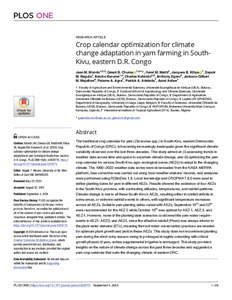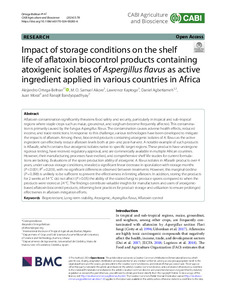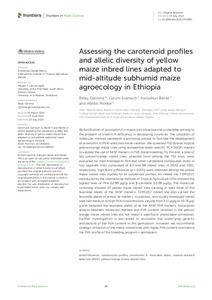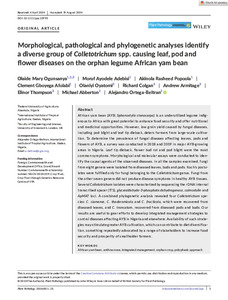Welcome to the International Institute of Tropical Agriculture Research Repository
Journal and Journal Articles: Recent submissions
Now showing items 61-80 of 5277
-
"The bad job brings the good one": photovoice study with female and male waste workers in Rwanda
(2024)Within the circular economy framework in Africa, sustainable waste management can contribute to improving the environment and creating green jobs. However, recycling activities are mostly carried out by informal workers, who are often forgotten in discussions about the circular economy. To ensure the development of a socially just circular economy, their voices must be heard and their needs accounted for. This study took place in Rwanda, a circular economy leader in Africa, and explored the ... -
Trend of soil salinization in Africa and implications for agro-chemical use in semi-arid croplands
(2024-11-15)Soil salinization is a gradual degradation process that begins as a minor problem and grows to become a significant economic loss if no control action is taken. It progressively alters the soil environment which eventually negatively affects plants and organism that were not originally adapted for saline conditions. Soil salinization arises from diverse sources such as side-effects of long-term use of agro-chemicals, saline parent rocks, periodic inundation of soil with saline water, etc. In Africa, ... -
Genomic prediction of the performance of tropical doubled haploid maize mines under artificial Striga hermonthica (Del.) Benth. infestation
(2024-08-12)Striga hermonthica (Del.) Benth., a parasitic weed, causes substantial yield losses in maize production in sub-Saharan Africa. Breeding for Striga resistance in maize is constrained by limited genetic diversity for Striga resistance within the elite germplasm and phenotyping capacity under artificial Striga infestation. Genomics-enabled approaches have the potential to accelerate identification of Striga resistant lines for hybrid development. The objectives of this study were to evaluate the ... -
Genetic diversity, linkage disequilibrium, and population structure in a common bean reference collection
(2024-05-08)An in-depth understanding of the extent and pattern of genetic diversity and population structure in crop populations is of paramount importance for any crop improvement program to efficiently promote the translation of genetic diversity into genetic gain. A reference collection of 150 common bean genotypes selected from the International Center for Tropical Agriculture’s global core collection was evaluated using single-nucleotide polymorphism (SNP) markers to quantify the amount of genetic ... -
Genetic diversity of whiteflies colonizing crops and their associated endosymbionts in three agroecological zones of Cameroon
(2024-08-30)Bemisia tabaci (Gennadius) is as a major pest of vegetable crops in Cameroon. These sap-sucking insects are the main vector of many viruses infecting plants, and several cryptic species have developed resistance against insecticides. Nevertheless, there is very little information about whitefly species on vegetable crops and the endosymbionts that infect them in Cameroon. Here, we investigated the genetic diversity of whiteflies and their frequency of infection by endosymbionts in Cameroon. ... -
A case of transdisciplinarity and collaborative decision making: the co-construction of Gendered Food Product Profiles
(2024-06)Crop breeding in sub-Saharan Africa has made considerable gains; however, postharvest and food-related preferences have been overlooked, in addition to how these preferences vary by gender, social difference and context. This context is changing as participatory approaches using intersectional gender and place-based methods are beginning to inform how breeding programmes make decisions. This article presents an innovative methodology to inclusively and democratically prioritise food quality traits ... -
Modeling integrated soil fertility management for maize production in Kenya using a Bayesian calibration of the DayCent model
(2024-08-22)Sustainable intensification schemes such as integrated soil fertility management (ISFM) are a proposed strategy to close yield gaps, increase soil fertility, and achieve food security in sub-Saharan Africa. Biogeochemical models such as DayCent can assess their potential at larger scales, but these models need to be calibrated to new environments and rigorously tested for accuracy. Here, we present a Bayesian calibration of DayCent, using data from four long-term field experiments in Kenya in a ... -
First evidence on the occurrence of multi‑mycotoxins and dietary risk exposure to AFB1 along the cassava value chain in Uganda
(2024-09-17)This study investigated the occurrence and distribution of multiple mycotoxins (aflatoxin B1, B2, G1, G2, feminizing B1, B2, ochratoxin A (OTA), deoxynivalenol (DON), zearalenone (ZEN), and citrinin (CIT)) in cassava products and as assessed the potential risk of aflatoxin B1 (AFB1) exposure among cassava consumers. A total of 192 samples of Cassava products (96 four and 96 chips, each with 48 samples from farmer and 48 from wholesaler) were analyzed using LC/MS–MS. All positive samples irrespective ... -
Framing behaviour change for sustainable agriculture: themes, approaches, and future directions
(2025-01)Despite the growing demand for behaviour change research and the benefit of understanding how human behaviour influences use cases and the adoption of agricultural innovations, research on how behaviour change occurs and the state of knowledge in the field remains scarce. To address this concern, this study conducted a systematic literature review of behaviour change in sustainable agriculture between 2015 and 2024. Our search identified 568 studies. After careful evaluation, 74 primary studies ... -
Crop calendar optimization for climate change adaptation in yam farming in South- Kivu, eastern D.R. Congo
(2024-09-04)The traditional crop calendar for yam (Dioscorea spp.) in South-Kivu, eastern Democratic Republic of Congo (DRC), is becoming increasingly inadequate given the significant climatic variability observed over the last three decades. This study aimed at: (i) assessing trends in weather data across time and space to ascertain climate change, and (ii) optimizing the yam crop calendar for various South-Kivu agro-ecological zones (AEZs) to adapt to the changing climate. The 1990–2022 weather data series ... -
Impact of storage conditions on the shelf life of aflatoxin biocontrol products containing atoxigenic isolates of Aspergillus favus as active ingredient applied in various countries in Africa
(2024-09-10)Aflatoxin contamination significantly threatens food safety and security, particularly in tropical and sub-tropical regions where staple crops such as maize, groundnut, and sorghum become frequently affected. This contamination is primarily caused by the fungus Aspergillus favus. The contamination causes adverse health effects, reduced income, and trade restrictions. In response to this challenge, various technologies have been developed to mitigate the impacts of aflatoxin. Among these, biocontrol ... -
Native arbuscular mycorrhizal fungi promote Plukenetia volubilis growth and decrease the infection levels of Meloidogyne incognita
(2024-06-27)The use of arbuscular mycorrhizal fungi (AMF) offers promising benefits to agriculture in the Amazon regions, where soils are characteristically acidic and nutrient-poor. The purpose of this research was to investigate the potential effects of two recently described species of AMF (Nanoglomus plukenetiae and Rhizoglomus variabile) native to the Peruvian Amazon for improving the plant growth of Plukenetia volubilis (inka nut or sacha inchi) and protecting the roots against soil pathogens. Two assays ... -
Occurrence and distribution of major cassava pests and diseases in cultivated cassava varieties in western Kenya
(2024-09-15)Cassava is an important food crop in western Kenya, yet its production is challenged by pests and diseases that require routine monitoring to guide development and deployment of control strategies. Field surveys were conducted in 2022 and 2023 to determine the prevalence, incidence and severity of cassava mosaic disease (CMD) and cassava brown streak disease (CBSD), whitefly numbers and incidence of cassava green mite (CGM) in six counties of western Kenya. Details of the encountered cassava ... -
Climate-resilient aquatic food systems require transformative change to address gender and intersectional inequalities
(2024-07-16)The adverse impacts of climate change on aquatic food systems (AFS) and the people who depend on AFS for livelihood security are inequitably distributed between and within countries. People facing the highest risks and experiencing the severest impacts of climate change are those who already experience multidimensional inequalities in their lives, particularly because of their gender, class, age, indigeneity, ethnicity, caste, religion, and the physical and political conditions that can create ... -
Assessing the carotenoid profiles and allelic diversity of yellow maize inbred lines adapted to mid-altitude subhumid maize agroecology in Ethiopia
(2024-07-23)Biofortification of provitamin A in maize is an attractive and sustainable remedy to the problem of vitamin A deficiency in developing countries. The utilization of molecular markers represents a promising avenue to facilitate the development of provitamin A (PVA)-enriched maize varieties. We screened 752 diverse tropical yellow/orange maize lines using kompetitive allele-specific PCR (KASP) makers to validate the use of KASP markers in PVA maize breeding. To this end, a total of 161 yellow/orange ... -
Morphological, pathological and phylogenetic analyses identify a diverse group of Colletotrichum spp. causing leaf, pod and flower diseases on the orphan legume African yam bean
(2024-09-02)African yam bean (AYB; Sphenostylis stenocarpa) is an underutilized legume indigenous to Africa with great potential to enhance food security and offer nutritional and medicinal opportunities. However, low grain yield caused by fungal diseases, including pod blight and leaf tip dieback, deters farmers from large‐scale cultivation. To determine the prevalence of fungal diseases affecting leaves, pods and flowers of AYB, a survey was conducted in 2018 and 2019 in major AYB‐growing areas in Nigeria. ... -
Assessing the effect of provitamin a on maize field resistance to aflatoxin and fumonisin contamination
(2024-11)Vitamin A deficiency in sub-Saharan Africa is mainly being addressed through crop biofortification. Several high provitamin A (PVA) maize varieties have been released as part of these measures. However, these varieties are grown in areas where Aspergillus ear rot (AER) and Fusarium ear rot (FER) frequently occur, leading to contamination with mycotoxins, which in turn reduce the yield and grain quality. Chronic mycotoxin exposure leads to serious public health problems. Therefore, PVA maize varieties ... -
Exploring the genetic diversity and population structure of aerial yams (Dioscorea bulbifera L.) DArT-seq and agronomic traits
(2024-08-23)Dioscorea bulbifera is an edible yam specie with aerial bulbils. Assessing the genetic diversity of D. bulbifera accession for cultivation and breeding purposes is essential for it genetic improvement, especially where the crop faces minimal attention. The aims of this study was to assess the genetic diversity of Dioscorea bulbifera accessions collected from Nigeria and accessions maintained at the genebank of International Institute of Tropical Agriculture (IITA) Ibadan. Accessions were profiled ... -
Long read sequencing and assembly of wild diploid relatives and cultivars in support of banana breeding programs
(2024-09)Banana is an important fruit and staple crop, which is vital for food and income security in developing countries. A genomics initiative was undertaken as part of the Global Alliance against TR4 (Tropical Race 4 of Fusarium Wilt of Banana) Alliance, with Bayer Crop Science, International Institute of Tropical Agriculture, and University of Queensland to collectively accelerate the breeding efforts in Eastern Africa. The goal of this project is to develop genomics resources to improve banana breeding, ... -
Evaluating the dry matter content of raw yams using hyperspectral imaging spectroscopy and machine learning
(2024-11)Yams (Dioscorea spp.) are important food and commercial crops in West African countries. They contribute significantly to global food production and provide dietary energy. The quality of yam food products depends on specific internal and external parameters, such as the DMC and other biochemical traits. However, measuring these traits can be challenging, particularly when analyzing many genotypes. This study aimed to evaluate the feasibility of using near-infrared (NIR) hyperspectral imaging ...












